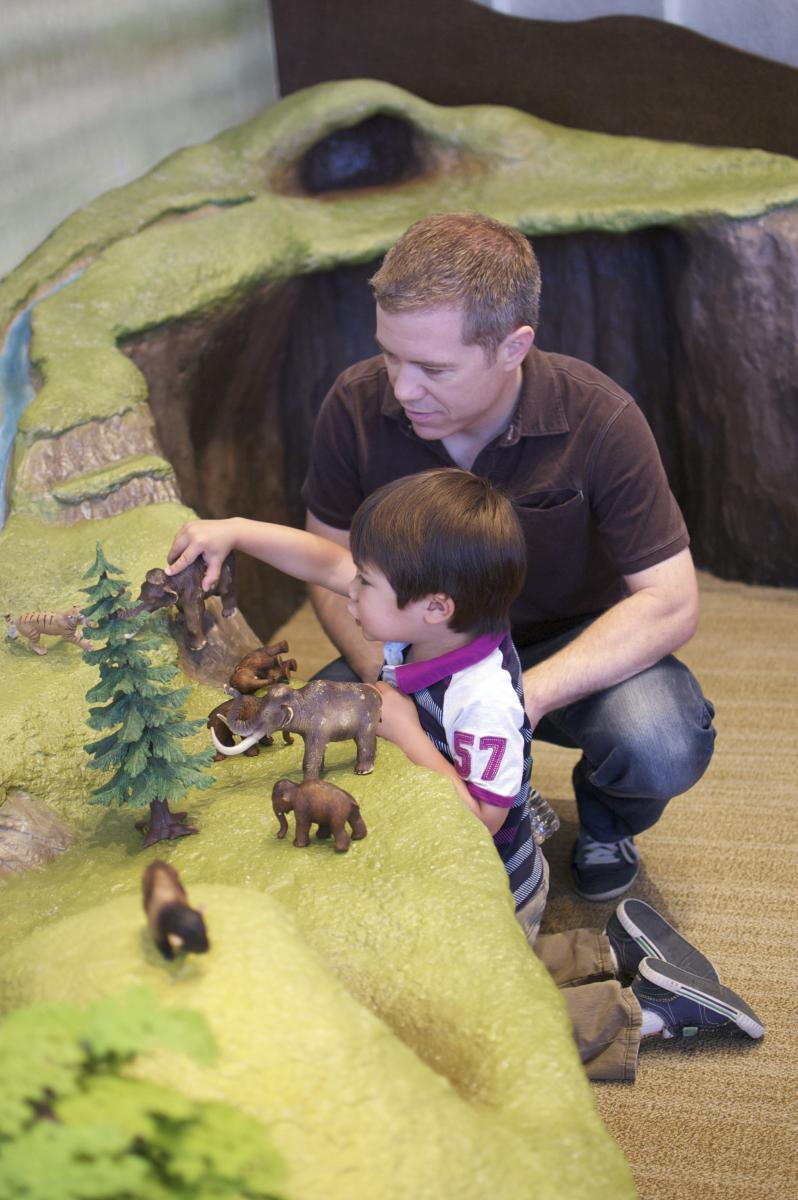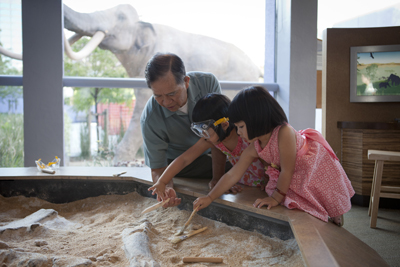Lupe's Story
To produce a public exhibition to study how children use evidence to construct scientific explanations, the Children’s Discovery Museum of San Jose (CDM), in collaboration with the University of California, Santa Cruz (UCSC) Department of Psychology and the University of California, Berkeley Museum of Paleontology (UCMP), launched Lupe’s Story, a Full Scale Development project funded in 2008 by the National Science Foundation (award #DRL-0741583).
The exhibition, now titled Mammoth Discovery!, uses the local discovery of a fossilized Columbian Mammoth to address the questions: How can we better understand how children use evidence to develop scientific explanations, and how can we apply what we learn to improve practice in children’s museums?

The project is comprised of four deliverables:
- research conducted by UCSC focusing on how families use evidence to construct scientific explanations and ways to facilitate such reasoning;
- a 2,300–square-foot permanent exhibition serving as a domain-rich (content-specific) setting for conducting research, in which children engage in increasingly sophisticated uses of evidence to create their own stories about mammoths;
- an educational website leveraging the paleontology resources of UCMP;
- and a professional development component for children’s museum professionals.
The exhibit deliverable, Mammoth Discovery!, opened in June 2011, following extensive prototyping and research, by Dr. Maureen Callanan and her lab at UCSC. The exhibit, designed for children ages 5-10, includes three mammoth fossils (skull, femur, and pelvis), excavated and prepared by UCMP, 18 hands-on exhibits including two dig pits and a shadow wall showcasing animal femurs, and access to the Mammoth Discovery! website. Developed by UCMP, the web site encourages children to discover, find out more, and tell their stories. To date, 450,000 children and their families have explored the exhibition.

Summative evaluation conducted by Randi Korn and Associates indicates that the exhibition is especially effective in encouraging caregivers to engage with their children in the inquiry process. All of the participants in the professional development component of the project have formed partnerships with local researchers as a result of their participation in this project.
Lessons Learned
Partnerships were essential to success. Each organization brought its expertise and openness to learning from the other institutions. The success of this project relied on the balance of strengths: CDM brought expertise in exhibition development and a tried and true, in-depth process of prototyping; Dr. Callanan’s lab at UCSC contributed expertise in coding family conversation data and discussing findings to facilitate the team’s deeper understanding of children’s learning to inform the exhibit development process; and our partners at UCMP brought deep content and process expertise to ensure scientific accuracy to the exhibit and the website.
A community of learners approach brought depth, breadth, and investment. Participants in the professional development component of the project appreciated and learned from the long term involvement in the project, where they had influence on the outcomes.
Evidence explanations are reinforced through experiences with narrative. Initial analysis of data gathered by Dr. Callanan’s lab indicates exhibit components that intentionally included narrative such as Story Sequencing, where children use wooden cards to talk about mammoths and their lives, contributed to a deeper understanding by children. For children, activating fossils with interactive experiences appears to deepen their understanding. Some preliminary work by Dr. Callanan suggests that evidence talk may also be more frequent when a hands-on component is added to the authentic fossils, encouraging the inquiry process.
Process is as important as content. As reported in the professional development summative evaluation, one participant noted: “The workshop sensitized me to the fact that the process of doing science is equally valuable to the content knowledge gained. Coming from a natural history background, I’m inclined to measure success by the knowledge visitors have gained on a particular topic. The workshop reassured me that having families participate in a process of inquiry was as important, if not more important, than the facts they retained at the end. This emphasis in helping kids learn how to think, rather than what to think, was significant in shifting my personal priorities.”

The Mammoth Discovery! project has provided positive learning experiences for all involved — CDM staff, researchers, scientists, museum colleagues, and visitors — and the desire to discover, find out more, and tell the story continues to be a driving force in our work on this project and others.
Project Team
- PI: Jenni Martin, Director of Education, Children’s Discovery Museum
- Co-PI: Dr. Maureen Callanan, Professor, University of California, Santa Cruz
- Co-PI: Judy Scotchmoor, Vice President of Education, University of California Museum of Paleontology